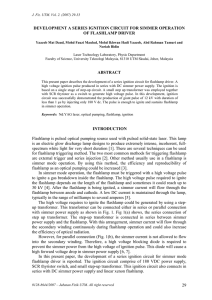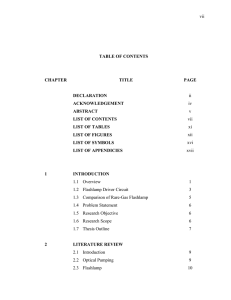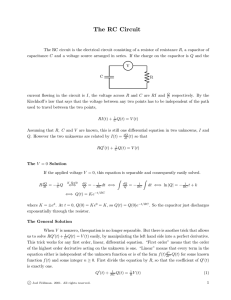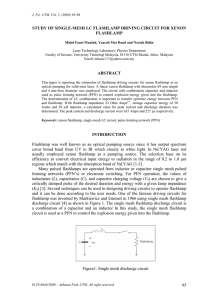Document 14558377
advertisement
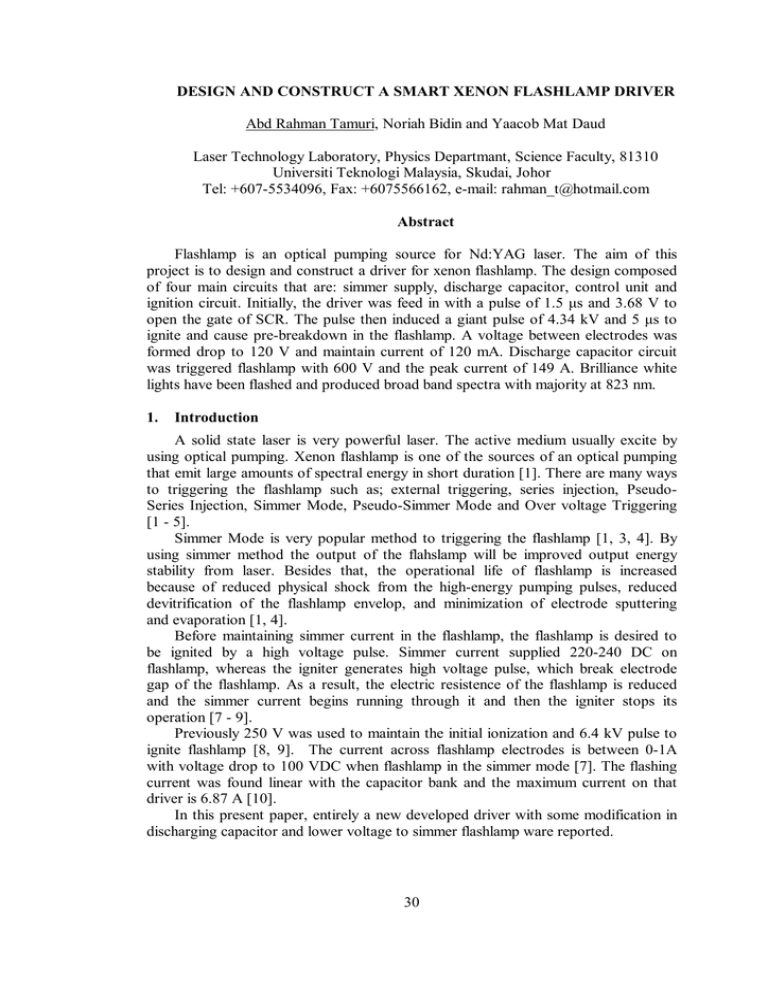
DESIGN AND CONSTRUCT A SMART XENON FLASHLAMP DRIVER Abd Rahman Tamuri, Noriah Bidin and Yaacob Mat Daud Laser Technology Laboratory, Physics Departmant, Science Faculty, 81310 Universiti Teknologi Malaysia, Skudai, Johor Tel: +607-5534096, Fax: +6075566162, e-mail: rahman_t@hotmail.com Abstract Flashlamp is an optical pumping source for Nd:YAG laser. The aim of this project is to design and construct a driver for xenon flashlamp. The design composed of four main circuits that are: simmer supply, discharge capacitor, control unit and ignition circuit. Initially, the driver was feed in with a pulse of 1.5 ìs and 3.68 V to open the gate of SCR. The pulse then induced a giant pulse of 4.34 kV and 5 ìs to ignite and cause pre-breakdown in the flashlamp. A voltage between electrodes was formed drop to 120 V and maintain current of 120 mA. Discharge capacitor circuit was triggered flashlamp with 600 V and the peak current of 149 A. Brilliance white lights have been flashed and produced broad band spectra with majority at 823 nm. 1. Introduction A solid state laser is very powerful laser. The active medium usually excite by using optical pumping. Xenon flashlamp is one of the sources of an optical pumping that emit large amounts of spectral energy in short duration [1]. There are many ways to triggering the flashlamp such as; external triggering, series injection, PseudoSeries Injection, Simmer Mode, Pseudo-Simmer Mode and Over voltage Triggering [1 - 5]. Simmer Mode is very popular method to triggering the flashlamp [1, 3, 4]. By using simmer method the output of the flahslamp will be improved output energy stability from laser. Besides that, the operational life of flashlamp is increased because of reduced physical shock from the high-energy pumping pulses, reduced devitrification of the flashlamp envelop, and minimization of electrode sputtering and evaporation [1, 4]. Before maintaining simmer current in the flashlamp, the flashlamp is desired to be ignited by a high voltage pulse. Simmer current supplied 220-240 DC on flashlamp, whereas the igniter generates high voltage pulse, which break electrode gap of the flashlamp. As a result, the electric resistence of the flashlamp is reduced and the simmer current begins running through it and then the igniter stops its operation [7 - 9]. Previously 250 V was used to maintain the initial ionization and 6.4 kV pulse to ignite flashlamp [8, 9]. The current across flashlamp electrodes is between 0-1A with voltage drop to 100 VDC when flashlamp in the simmer mode [7]. The flashing current was found linear with the capacitor bank and the maximum current on that driver is 6.87 A [10]. In this present paper, entirely a new developed driver with some modification in discharging capacitor and lower voltage to simmer flashlamp ware reported. 30 2. Methodology Figure 1 shows the block diagrams of flashlamp driver system. The system was divided to four main circuits: Simmer Current Supply, Discharge Capacitor, Igniter Circuit and Control unit. Simmer Current Supply Power Supply Discharging Capacitor SCR, Cap. Bank Control unit PIC16F84A Xenon flashlamp Igniter Circuit SCR, HV Transformer Figure 1: Block diagram of the overall circuit in simmer current supply Power of 230 VAC was supplied to all circuits in the system. Control unit that using PIC16F84A as controller allows single pulse operation. After pre-breakdown with 3.43 kV pulse, the simmer current was suffusion. The initial voltage was tested to respond with the pre-breakdown pulse. In additional a minimum voltage for simmer flashlamp was also identified by varying the input voltage supply. The optimum value of flashlamp both for simmer and initial voltage was determined by considering the energy consumption, characteristic and the output shape. Control unit was designed to control overall system in this setup. The heart of this unit is a PIC16F84A microcontroller. A crystal oscillator 8.0 MHz is used to clocking PIC. This setup used mikroBasic Version 1.1.6.0 to program PIC microcontroller. Control unit was protected by pulse transformer and BC547 transistor. Ignition circuit used to ignite the flashlamp. A short pulse about 3.43 kV has been produced by this circuit. The pulse will be produced when a SCR 2N6399 was open. The duration time of this pulse is 5 ìs. The role of simmer circuit was to maintain the flashlamp in ready mode to flashing state. The threshold voltage to respond ignition pulse is 220 V. Diode employed to prevent the high voltage from the other circuit such as ignition and discharge capacitor. Voltage of 233 VDC has been utilized to simmer the flashlamp. The capacitor bank of 110 ìF was provided to trigger flashlamp. A SCR was used to control voltage of triggering. Before the gate of SCR is open, a relay was used to stop the main power supply in this circuit. When the gate of SCR is open, the capacitor bank will be discharged. The SCR will automatically turn off when the cathode voltage is greater than the anode. A high voltage probe model Tektronix P6015 was employed to detect signal provided from the circuit. The probe was connected to an oscilloscope model 31 Tektronix TDS3054B. A CCD spectrum analyzer model Ophir Wave Star was used to detect the light during flashing. 3. Result and Discussion Figure 2: the Control unit signal to ignite flashlamp Figure 3: 4.34kV pulse signal to ignite flashlamp The construction of driver was successfully developed and able to trigger xenon flashlamp. Figure 2 and Figure 3 show the signal from control unit and ignition circuit respectively. A short pulse about 1.5 us from control unit was triggering the SCR gate. As the result, the igniter circuit produced 5 ìs pulse with 4.34 kV. This pulse was enough to breakdown the gas in the flashlamp. Figure 3 shows the simmer current supply is ready to respond the ignition signal. After the ions were generated, the voltage of simmer supply was reduced down to 120 V. Figure 4 shows the signal of discharging capacitor. The signal shows that, discharging time is 40 ìs. A short time is required to discharge capacitor. This is reasonable since, the shorten time to discharge, the higher current will produce, which satisfied the equation of: dQ (1) I dt Figure 5 shows the peak current due the flashing. The maximum current obtained was 149 A. The current was measured at a 1 Ω resistor which in series with the flashlamp. The voltage on the resistor is given: (2) V IR The current is equal to voltage when R = 1 Ω. The voltage profile is similar with current profile. Figure 4: First discharging capacitor signal Figure 5: The current signal when flashing 32 Figure 6: Flashlamp spectrum emission in range 600 -1020 nm Figure 6 shows the spectrum of flashlamp emission in range 600-1020 nm. The spectrum was measured by OPHIR Wave Star Spectrometer. The band of the spectrum emission is in between 790 to 920 nm with the higher peak at 823.31 nm. The Nd:YAG laser need to pump at the region 0.73 to 0.82 ìm [1, 2]. 4. Conclusion The flashlamp driver that consists of simmer current supply, ignition circuit, control unit and discharge capacitor circuit was successfully developed. The ignition used to breakdown the flashlamp and the simmer current supply maintains flashlamp in simmer mode. When discharge capacitor circuit triggered flashlamp, the bright white light was produced. The peak current is 149 A and the majority of spectrum between 790-920 nm has been produced. 5. Acknowledgement The authors would like to thank to the government of Malaysia through IRPA for the financial support in this project. Thanks are also to due Universiti Teknologi Malaysia for supporting this project. 6. References [1] Koechner W. (2003), “Solid State Laser Engineering: A Graduate Text”, New York: Springer Varlag, pg. 187-198 [2] K. L. Kuhn (1998), “Laser Engineering”, Prentice-Hall Inc., USA, pg 315-325 [3] R.Arya, Joy M. Thomas, A. G. Bhujle & D. D. Bhawalkar, “ Effects of Simmer Current on Flashlamp Impedence and their combined influence on the output of a Quasi-CW Nd:YAG laser”, IEEE Journal of Quantum Electronics, Vol. 36, No. 7, July 2000 [4] R. P. Farnsworth, “Wide band, high efficiency simmer power supply for a laser flashlamp”, US Patent, December 17, 1985 (USPTO 4910438) [5] J. R. Oliver & F. S. Barnes, “Rare-gas pumping efficiencies for Neodymium Lasers”, IEEE Journal of Quantum Electronics, Vol. QE-5, No. 5, May 1969 [6] J. R. Oliver & F. S. Barnes, “A comparison of rare-gas Flashlamp” , IEEE 33 Journal of Quantum Electronics, Vol. QE-5, No. 5, May 1969 [7] Yerevan (2004), Flashlamp Driver FLD 1500/100 Operation Manual, Arnimia [8] Hadi A. A, Johari A & Noriah B (2005), “Development of simmer driver for a xenon flashlamp” , Annual Fundamental Science Seminar (AFSS2005), 4-5 July, Ibnu Sina Institute, UTM Skudai [9] Hadi A. A, Johari A. & Noriah B (2005), “Pre-Triggering programmable flashlamp driver with simmer method”, Proc. International meting on Frontier of Physics, Mins Beach Result and SPA, Kuala Lumpur, 25-29 July 2005. [10] M. M. Fauzi, Hadi A. A, Johari A. & Noriah B (2005), “Characterized Flashlamp Triggered by Simmer Mode”, 1st National Photonics Colloquium 2005(NPC05), 29th-30th November 2005, Esset, Kajang 34
